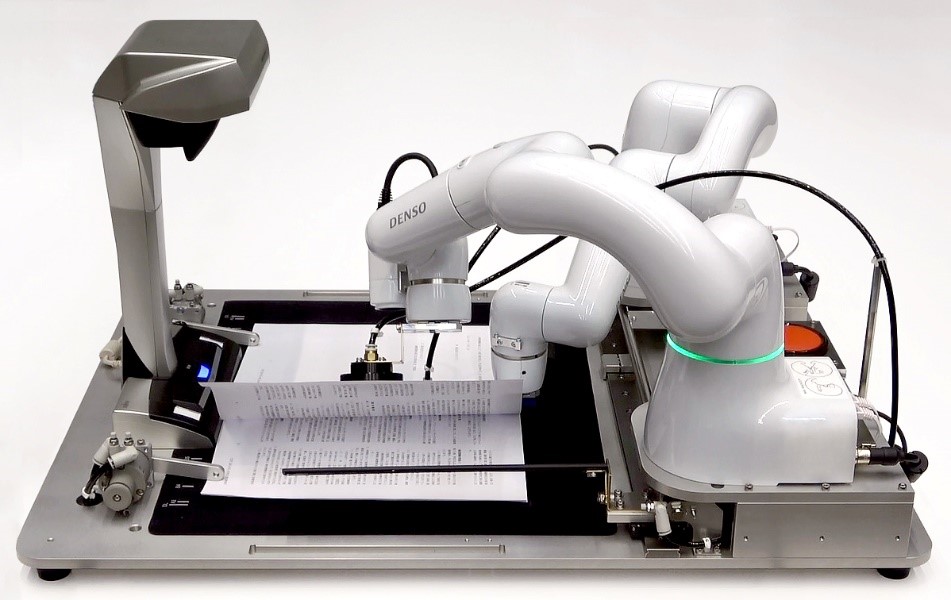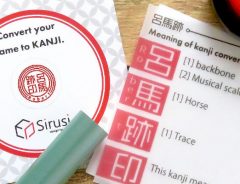
Source: © PR Times, Inc.
Japanese Robotics Solution Stamps Hanko And Signs Contracts, Baffles Twitter Users
- Source:
- © PR Times, Inc.
- Tags:
- automation / Denso Wave / Hanko / Hitachi Capital / Hitachi Systems / Robot / Seal / Stamp
Related Article
-

Noodle robot dishes out soba to hungry commuters
-

The Many Faces of Pepper The Empathetic Humanoid Robot
-

A Humanoid Buddy In Your Pocket: A Phone That Is Also A Walking Robot!
-

Japan’s cuddly robot gets permanent themed cafe with new LOVOT Cafe in Kanagawa
-

Convert Your Name To Kanji And Stamp It Your Way With Personalized Japanese Hanko Seals
-

Marie from The Aristocats version of therapy robot has white fur and pink ribbon


Hanko culture in the digital age
While a growing number of banks and government bodies now allow customers to handle their business digitally and do away with the traditional hanko seals (used in lieu of signatures in Japan), the venerable hanko doesn't seem to be in danger of disappearing any time soon.
According to the Asahi Shimbun, recently-appointed IT Minister Naokazu Takemoto, who also happens to chair the Parliamentary Association to Protect Japan's Seal System and Culture 日本の印章制度・文化を守る議員連盟, announced in a press conference on September 12th that hanko makers' survival is at stake, so replacing hanko with digital signatures cannot be rushed. He then added "Seals and digital society should not be regarded as conflicting things," and that it's possible to let them flourish together.
Hanko tech
Whether by coincidence or the result of developments spurred by Takemoto's pronouncements, Denso Wave Co., Ltd., Hitachi Capital Co., Ltd. and Hitachi Systems, Ltd. have just announced their “RPA & COBOTTA Automation Support for Offices,” a jointly-developed robotics solution capable of automating a series of operations to physically turn pages, stamp documents (such as contracts and other official documents) with a hanko seal and then digitize them.
According to Denso Wave's press release, the collaborative robot “COBOTTA” "can automatically sign contracts and electronic documents ... thereby contributing to the automation of office operations in response to customer needs for operational efficiency, labor savings, and productivity improvement."
The COBOTTA collaborative robot has been used in various applications thus far. For example, in this demonstration video from FOOMA 2018, you can see a pair of COBOTTA "chefs" working in unison to make gyoza (Japanese dumplings)
For those who are interested, the robotics solution will be exhibited at the "2019 International Robot Exhibition" held at Tokyo Big Sight From December 18 (Wed) to 21 (Sat), 2019.
Twitter Reacts
This surprising development caused a minor sensation on Twitter, with many users wondering if the news was true. While criticism seemed to dominate, there were positive comments as well.
Kyokō Shimbun 虚構新聞, Japan's oldest and most famous satyrical news site, found it necessary to tweet the following:
"Please note that the 'automatic hanko stamping robot' is not (the subject of) one of our articles. It is real."
Some commented on potential legal problems:
"My company's legal rep told me: 'There's a very solid two-step assumption in (Japanese) law which goes: 'X stamped a seal, therefore X stamped it of his/her own will, therefore the document is valid.' However, the appearance of this robot calls the first assumption into question. It could turn out to be the end of the road for hanko culture.' What an eye-opener! It's fun to talk to experts in all kinds of fields."
Others were more indirect in their criticism, looking at it as modern art...
"Interesting. You could even make the argument that 'this is media art.' Revealing the distortions of reality could only be art."
...or making a cynical jab at one of the often-derided aspects of "hanko culture" whereby subordinates (from the right, in order of hierarchy) tilt their seal in a simulated bow to the hanko (and its owner) with the most authority (at left):
"About that robot which flips pages of contracts and automatically stamps a hanko, there's going to be trouble if they don't add the 'Cool Japan stamp-bowing culture' into the specs..."
But other opinions were rather harsh:
" 'Wow, amazing, Japan!' ... Nah, nobody's thinking that lol. Hurry up and notice you're completely headed the wrong way!"
However, there were also opinions hinting that this robot was no laughing matter:
"Many people are making fun of this but there's a huge number of people who live on this kind of very specific optimization involving 'things which will eventually disappear' and 'things which ought to disappear,' so I think it's a boomerang."